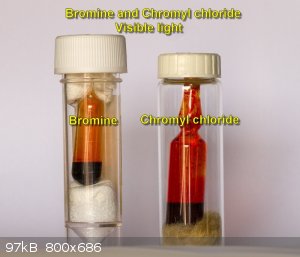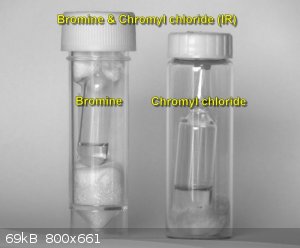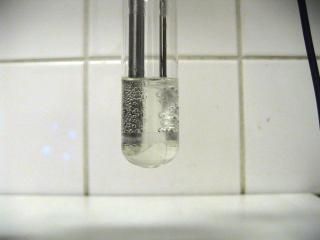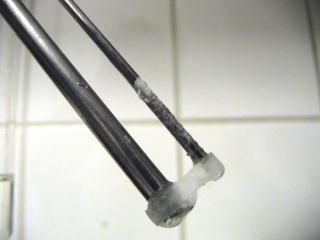| Pages:
1
2 |
nezza
Hazard to Others
  
Posts: 324
Registered: 17-4-2011
Location: UK
Member Is Offline
Mood: phosphorescent
|
|
Colours
As a keen photographer & chemist I have always been interested in pretty colours so have been synthesising/photographing interesting coloured
materials. I made some bromine a long time ago and have recently done a small scale synthesis of chromyl chloride (scary stuff) to compare the colour
with bromine in visible and infra red wavelengths. Both liquids look similar with chromyl chloride looking more reddish to me and bromine brownish.
Both are also transparent to Infra Red. I have also uploaded a slow motion video of samarium dissolving in acid to give Sm2+ (blood red) as a
transient colour.
 
Attachment: Samarium.mp4 (2.7MB)
This file has been downloaded 721 times
|
|
|
blogfast25
International Hazard
    
Posts: 10562
Registered: 3-2-2008
Location: Neverland
Member Is Offline
Mood: No Mood
|
|
Quote: Originally posted by nezza  | I have also uploaded a slow motion video of samarium dissolving in acid to give Sm2+ (blood red) as a transient colour.
|
Are you sure that this is Sm (II)?
With regards to SmCl<sub>3</sub> Wiki states that:
"it can also be prepared from samarium metal and hydrogen chloride.[3][4]
2 Sm + 6 HCl → 2 SmCl3 + 3 H2
Aqueous solutions of samarium(III) chloride can be prepared by dissolving metallic samarium or samarium carbonate in hydrochloric acid."
The Ln elements strike me as electropositive enough to be oxidised by H<sub>3</sub>O<sup>+</sup>(aq) (from hydrochloric acid)
to their III oxidation states, including those that exhibit also the II oxidation state.
The Sm (III) salts are yellow, as solids, not red.
Nice video, BTW...
|
|
|
nezza
Hazard to Others
  
Posts: 324
Registered: 17-4-2011
Location: UK
Member Is Offline
Mood: phosphorescent
|
|
Yes Samarium III is virtually colourless, but in a reducing environment the Sm II ion can exist. It is blood red in colour. The video is of samarium
dissolving in Hydrochloric acid and the solution goes colourless as soon as all of the metal is dissolved.
|
|
|
Eddygp
National Hazard
   
Posts: 858
Registered: 31-3-2012
Location: University of York, UK
Member Is Offline
Mood: Organometallic
|
|
Last two weeks I was at a work experience program thingy and they were working with perylene-diimides and various complex asymmetric phthalocyanines.
I was surprised because I didn't expect so many brilliant colours that changed depending on the concentration in the solvent and how they changed,
visibly, during the reactions that they went through.
there may be bugs in gfind
[ˌɛdidʒiˈpiː] IPA pronunciation for my Username |
|
|
woelen
Super Administrator
        
Posts: 7977
Registered: 20-8-2005
Location: Netherlands
Member Is Offline
Mood: interested
|
|
The samarium is quite interesting. Do you also get the red color if you add powdered zinc to a nearly colorless solution of Sm(3+) in dilute
hydrochloric acid?
----------------------------------------------------------------------------
How old is your ampoule of CrO2Cl2? I also made some of this stuff several years ago:
http://woelen.homescience.net/science/chem/compounds/chromyl...
I made a few drops of the chemical, made pictures and did some experiments, but did not keep it around for more than a day. I read in an old text book
that CrO2Cl2 slowly decomposes, giving chromium(III) oxide/chloride and oxygen. If you have the liquid in a sealed ampoule, then (if the book is
correct) it will explode due to overpressure at some bad day. Maybe I am wrong and it is safe to keep the compound around, but I just want to mention
it to you.
|
|
|
blogfast25
International Hazard
    
Posts: 10562
Registered: 3-2-2008
Location: Neverland
Member Is Offline
Mood: No Mood
|
|
Quote: Originally posted by nezza  | | Yes Samarium III is virtually colourless, but in a reducing environment the Sm II ion can exist. It is blood red in colour. The video is of samarium
dissolving in Hydrochloric acid and the solution goes colourless as soon as all of the metal is dissolved. |
That's very interesting.
Try what woelen suggested, although the electrochemical series should provide the answer as to what will happen/not happen.
|
|
|
nezza
Hazard to Others
  
Posts: 324
Registered: 17-4-2011
Location: UK
Member Is Offline
Mood: phosphorescent
|
|
The vial I photographed is fresh. I always keep it double bottled in case of accident (It's really nasty stuff). I have an old vial with less than 1
ml in I prepared a year or so ago that is still intact. That one is a bit murky no so I will try snapping it observing adequate safety to see if there
has been a build up of pressure. As for the Zinc and Samarium question I will have a go.
|
|
|
woelen
Super Administrator
        
Posts: 7977
Registered: 20-8-2005
Location: Netherlands
Member Is Offline
Mood: interested
|
|
I tried the experiment with Sm2O3, dissolved in excess hydrochloric acid, as described by me above. When small granules of zinc are added to such a
very pale yellow solution, then a lot of hydrogen is produced, but not even a trace of the red color of Sm(2+) can be observed.
|
|
|
blogfast25
International Hazard
    
Posts: 10562
Registered: 3-2-2008
Location: Neverland
Member Is Offline
Mood: No Mood
|
|
Woelen:
My CRC ’86 gives:
Sm<sup>3+</sup> + e → Sm<sup>2+</sup>, with E<sub>Red</sub> = -1.55 V
Zn → Zn<sup>2+</sup> + 2 e, with E<sub>Ox</sub> = + 0.76 V
So this reduction of Sm (III) to Sm (II) with Zn is thermodynamically unfavourable: E<sub>Red</sub> + E<sub>Ox</sub> < 0
(Delta G > 0)
But both Mg and Al should do it with oxidation potentials of resp. + 2.372 and + 1.662 V
But I still find it puzzling the 'reducing conditions' in nezza's experiment can lead to Sm (II)... It seems to suggest that
H<sub>2</sub>/H<sup>+</sup> can reduce Sm (III) to Sm (II)? How?
[Edited on 9-7-2014 by blogfast25]
|
|
|
HgDinis25
Hazard to Others
  
Posts: 439
Registered: 14-3-2014
Location: Portugal
Member Is Offline
Mood: Who drank my mercury?
|
|
Samarium isn't like the other lanthanides in this aspect.
When the reaction kicks in, there are a lot of hydronium ions, comparing to the surface area of the samarium lump and the solutions isn't too hot, so
the following reaction happens (mind the water in the equation):
Sm(s) + 2H3O+(aq) = Sm2+(aq) + H2(g) + 2H2O(l)
Sm2+ is red in colour, that's why you see the solution go red. However Sm2+ is unstable in the presence of hydronium ions and, as the reaction goes
on, the solution gets hotter catalyzing the following reaction:
2Sm2+(aq) + 2H3O+(aq) = 2Sm3+(aq) + H2(g) + 2H2O(l)
|
|
|
woelen
Super Administrator
        
Posts: 7977
Registered: 20-8-2005
Location: Netherlands
Member Is Offline
Mood: interested
|
|
Exactly for that reason I found it still interesting to try the experiment with Zn in acid. Sometimes the use of Zn as reductor gives surprising
results. Not with Sm(3+) though.
Use of Al or Mg I can test, but I do not expect much of that, because the pure metals give very fast reactions with acids. Maybe the use of Devarda's
alloy gives better results. I have some of that as well.
---------------------------------------------------------
@nezza: What IR-filter did you use for the IR-pictures. I have seen modified cameras (e.g. Canon SX150 or Sony CyberShot), sold by a UK-based company,
where you must specify the filter to be built into the camera. Choices are
1) Monochrome Infrared: below 700nm opaque, above 800nm transparent, inbetween smooth transition from opaque to transparent.
2) Faux Colour Infrared: below 600nm opaque, above 695nm transparent, inbetween smooth transition from opaque to transparent.
3) Goldie: Below 550 nm opaque, above 550 nm transparent. Sharp transition from opaque to transparent at 550 nm.
4) Super Enhanced Colour: opaque below 650 nm, transparent above 750 nm, inbetween smooth transition from opaque to transparent. Also a /\-shaped area
with max. transparency around 460 nm.
5) Deep Contrast: below 850nm opaque, above 900nm transparent, inbetween smooth transition from opaque to transparent.
6) No filter, full spectrum (UV/VIS/IR)
What filter would be necessary for the kind of pictures you made of the Br2 and CrO2Cl2?
[Edited on 9-7-14 by woelen]
|
|
|
blogfast25
International Hazard
    
Posts: 10562
Registered: 3-2-2008
Location: Neverland
Member Is Offline
Mood: No Mood
|
|
Quote: Originally posted by woelen  | Use of Al or Mg I can test, but I do not expect much of that, because the pure metals give very fast reactions with acids. Maybe the use of Devarda's
alloy gives better results. I have some of that as well.
|
Why not part neutralise with ammonia, thus decreasing [H<sub>3</sub>O<sup>+</sup>] substantially? Then test the metals with
this quasi-neutral solution.
@HgDinis:
Yes, I can see that too but the question is WHY?
This has to be related to exactly how Sm is oxidised by hydronium ions.
[Edited on 9-7-2014 by blogfast25]
|
|
|
IrC
International Hazard
    
Posts: 2710
Registered: 7-3-2005
Location: Eureka
Member Is Offline
Mood: Discovering
|
|
Quote: Originally posted by woelen  | I have seen modified cameras (e.g. Canon SX150 or Sony CyberShot), sold by a UK-based company, where you must specify the filter to be built into the
camera. Choices are
1) Monochrome Infrared: below 700nm opaque, above 800nm transparent, inbetween smooth transition from opaque to transparent.
2) Faux Colour Infrared: below 600nm opaque, above 695nm transparent, inbetween smooth transition from opaque to transparent.
3) Goldie: Below 550 nm opaque, above 550 nm transparent. Sharp transition from opaque to transparent at 550 nm.
4) Super Enhanced Colour: opaque below 650 nm, transparent above 750 nm, inbetween smooth transition from opaque to transparent. Also a /\-shaped area
with max. transparency around 460 nm.
5) Deep Contrast: below 850nm opaque, above 900nm transparent, inbetween smooth transition from opaque to transparent.
6) No filter, full spectrum (UV/VIS/IR) |
Woelen is it possible to buy just the filters from this company? Below list is the dimensions of the IR block filters that come factory in these two
cameras. I have replaced them many times doing various experiments. Having no way to alter the built in software I have had to alter the thickness to
get the camera back into focus. A tedious, delicate (and intricate) job replacing them but easy after you do it a few times. Main trouble is keeping
dust out while working. I had toyed with building a uV version but no way can I afford to replace that big Zeis front lens with one made from a uV
transparent material. I have however found it does pass uV well enough to be useful if lighting is not too low. On your #6 in the list they must be
installing a transparent plate of exactly the correct thickness and index of refraction to maintain focus. Or are they able to alter the internal
software in the camera CPU? When you switch between night shot (or night framing) and normal a solenoid physically rotates the filter in or out of the
light path thus requiring focus to be readjusted (done automatically controlled by software to one of two focus alterations).
Sony DSC 707/717
1.24 mm thick, 12.95 mm X 10.95 mm IR block filter for CCD Assy.
Sony DSC 505
2.52 mm thick, 11 mm X 9.5 mm IR block filter for CCD Assy.
"Science is the belief in the ignorance of the experts" Richard Feynman
|
|
|
woelen
Super Administrator
        
Posts: 7977
Registered: 20-8-2005
Location: Netherlands
Member Is Offline
Mood: interested
|
|
I will not attempt to do this rebuilding myself. I have two new and good digital cameras (Panasonic DMC FZ 50 for more advanced photography, having a
very good lens and a Panasonic DMC FZ 200 which is somewhat less advanced, but has a very fast CCD and allows me to make movies at 200 frames per
second), and do not want to take these apart. I have another camera (Canon PowerShot 610), but that I have given to one of my children, who uses it
for decent photography. So, I have to purchase a camera anyway and then I feel more comfortable if I purchase a modified one for a decent second hand
price plus a few tens of euros for the mod. In this way I can get such a Canon SX150 for EUR 180 or so, completely converted and tested OK. Many
sellers sell this same camera for EUR 180, even without the conversion.
|
|
|
Brain&Force
Hazard to Lanthanides
    
Posts: 1302
Registered: 13-11-2013
Location: UW-Madison
Member Is Offline
Mood: Incommensurately modulated
|
|
I just happened upon this thread, and I have found a video that shows the exact same thing occurring with both samarium and praseodymium (skip to
0:46)
<iframe sandbox width="420" height="315" src="//www.youtube.com/embed/IFmAhhiam9g" frameborder="0" allowfullscreen></iframe>
The potential for the reaction Sm2+ + 2e- ⇌ Sm is -2.68 V. This is greater than the reaction Sm3+ + 3e-
⇌ Sm whose potential is -2.304 V. The oxidation to samarium(II) is favored as well as the oxidation to samarium(III), but the +2 state is too
reducing to be stable in water, so it oxidizes again in the presence of hydronium. A similar thing likely happens with praseodymium, but it's likely
moving up to the +4 state and being reduced to the +3 state.
Samarium(II) iodide, used in Barbier reactions and one-electron reductions, is blood red. It's normally prepared in THF, which is not oxidizing enough
to produce the +3 state by itself (but probably will with air).
At the end of the day, simulating atoms doesn't beat working with the real things...
|
|
|
Bezaleel
Hazard to Others
  
Posts: 444
Registered: 28-2-2009
Member Is Offline
Mood: transitional
|
|
I just tried to perform an electrolysis of a Sm(OAc)3 solution, 1 spatula tip full of small crystals that dissolved to an opalescent solution.
The reaction conditions were: 15V between electrodes (stainless steel), current: 230mA, electrode separation 6 mm (smallest distance). On the cathode
some precipitate formed, stronlgy resembling Sm2O3. No red colouring at all. I do know it is mentioned in literature that Sm2+(aq) has a strong red
colour, but it did not show up in this experiment.
Pictures of setup:

Some samarium acetate

Electrolysis at 12V, 230mA

Residue after electrolysis (about 1 minute)
|
|
|
blogfast25
International Hazard
    
Posts: 10562
Registered: 3-2-2008
Location: Neverland
Member Is Offline
Mood: No Mood
|
|
@B&F:
Great find, that video. You're giving me reasons to finally dissolve my SmCo magnet!
@Bezaleel:
You are electrolysing water but with a rather expensive electrolyte! The hydronium ions in the solution are much easier to reduce than the Sm(III)
ions and are reduced preferentially. The samarium acetate acts only as a charge carrier. 
To reduce Sm(III) by electrolysis would require an aprotic solvent, NOT water. Or an anhydrous molten salt of Sm.
[Edited on 9-7-2014 by blogfast25]
[Edited on 9-7-2014 by blogfast25]
|
|
|
Bezaleel
Hazard to Others
  
Posts: 444
Registered: 28-2-2009
Member Is Offline
Mood: transitional
|
|
Yes, was afraid of that, and the experiment proved it.
Fortunately, Sm isn't that expensive, if you are content with a 99.5% RE purity level, and take the oxide as your starting point.
|
|
|
Brain&Force
Hazard to Lanthanides
    
Posts: 1302
Registered: 13-11-2013
Location: UW-Madison
Member Is Offline
Mood: Incommensurately modulated
|
|
blogfast, removing samarium from a solution of samarium and cobalt should be trivial - add concentrated ammonia and let the cobalt complex away as the
samarium precipitates. Metallic Sm is only US$12 for 5 g, or $35 for 40g (at Metallium) so it's not expensive in that form either.
Does the samarium oxide or acetate fluoresce under shortwave UV?
At the end of the day, simulating atoms doesn't beat working with the real things...
|
|
|
nezza
Hazard to Others
  
Posts: 324
Registered: 17-4-2011
Location: UK
Member Is Offline
Mood: phosphorescent
|
|
Sorry about the delay in replying. The ir filter I use is 720nm.
|
|
|
woelen
Super Administrator
        
Posts: 7977
Registered: 20-8-2005
Location: Netherlands
Member Is Offline
Mood: interested
|
|
Thanks for the info, then I should take option 1 for a converted camera. Now I first need to get some budget for this, probably after holidays.
|
|
|
blogfast25
International Hazard
    
Posts: 10562
Registered: 3-2-2008
Location: Neverland
Member Is Offline
Mood: No Mood
|
|
Quote: Originally posted by Brain&Force  | | blogfast, removing samarium from a solution of samarium and cobalt should be trivial - add concentrated ammonia and let the cobalt complex away as the
samarium precipitates. UV? |
I'll still try the double sulphate method first, as it stinks less.
Some of these ammine complexes don't form so easily: the Ni one is quite hard. Dunno about the Co one...
|
|
|
Bezaleel
Hazard to Others
  
Posts: 444
Registered: 28-2-2009
Member Is Offline
Mood: transitional
|
|
| Quote: | Nickel on Atomistry
Preparation of Nickel Salts free from Cobalt
Another method consists in adding ammonia to the impure bromide in aqueous solution, whereby nickel bromide hexammoniate, NiBr2.6NH3, separates out in
beautiful violet crystals. Since cobalt does not yield a similar derivative under like conditions, a very pure salt of nickel may be obtained in this
way. The hexammoniate of nickel chloride, namely, NiCl2.6NH3, may similarly be used. |
So separating cobalt from samarium with ammonia may not be successful.
|
|
|
Brain&Force
Hazard to Lanthanides
    
Posts: 1302
Registered: 13-11-2013
Location: UW-Madison
Member Is Offline
Mood: Incommensurately modulated
|
|
The separation above relies on the fact that nickel is far, far more likely to complex under slightly alkaline conditions. Cobalt will just
precipitate with dilute ammonia - you need concentrated ammonia to get it to complex, then you need to oxidize it with hydrogen peroxide to stabilize
the complex in solution as hexaaminecobalt(III). Samarium doesn't complex at all, and will just precipitate as a white to slightly yellowish
hydroxide.
If I had a lab I would attempt this myself.
At the end of the day, simulating atoms doesn't beat working with the real things...
|
|
|
DraconicAcetate
Harmless

Posts: 5
Registered: 3-7-2014
Member Is Offline
Mood: No Mood
|
|
Cobalt does form a complex with ammonia. The nickel one simply has a low solubility with chloride or bromide counterions. The cobalt one will stay
in solution.
|
|
|
| Pages:
1
2 |